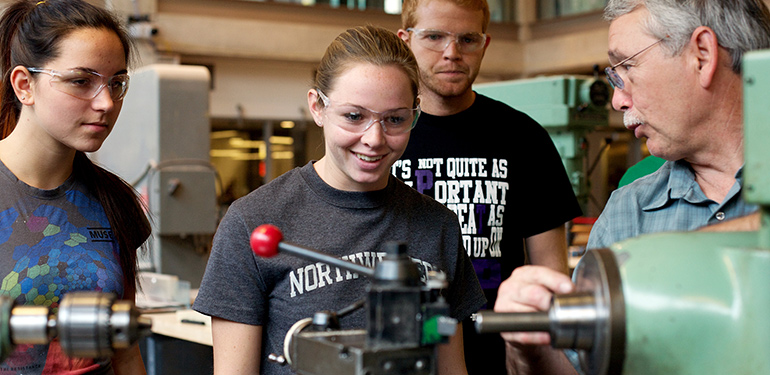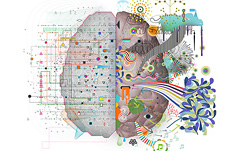Undergraduate Study / Core CurriculumEngineering First® Program
The Engineering First curriculum:
- provides first year students with engineering experiences immediately
- integrates engineering science and mathematics
- emphasizes design and the process of “design thinking”
Created in 1997, the Engineering First curriculum created a new pedagogy for engineering education and was nominated for a National Academy of Engineering award for educational excellence.
Jump to a Section
The Goals of Engineering first
- Engage McCormick’s students in engineering concepts right from the beginning of their freshman year.
- Establish in McCormick students the necessary concepts for doing engineering design, as an intellectual activity common to everyone with an engineering education.
- Engage McCormick faculty with students from the very start of their college careers.
By meeting these goals, Engineering First gives students the chance to engineer early with real engineers. This provides students an advantage in future pursuits such as research, academia, and careers in industry.
Innovative Curriculum
Engineering First consists of six courses in two sequences: Engineering Analysis and Design Thinking and Communication (DTC).
Engineering Analysis
Engineering Analysis is a series of four courses integrating math, science, and programming. The specific areas covered are:
- linear algebra
- engineering mechanics
- physics
- differential equations
- MATLAB programming
Each course is an integration of these topics with engineering applications. MATLAB is used throughout the sequence, which provides students with important tools to augment their professional development.
Design Thinking and Communication (DTC)
This two course sequence (DTC-1 in fall and winter, and DTC-2 in spring) puts students to work immediately on real design problems submitted by individuals, non-profits, entrepreneurs, and industry members.
In Design Thinking and Communication, students develop the ability to distinguish and solve the real problem behind a perceived problem. In the context of whole-brain engineering, it’s where right-brain thinking comes into its own.
Co-taught by McCormick faculty and faculty from the Weinberg College of Arts and Sciences Writing Program, DTC teaches the writing and presentation skills needed to thrive in a competitive marketplace.
As they develop well-honed communication skills, DTC students master design thinking, a process that leads to effective problem solving through a logical sequence:
- Study the problem
- Frame the problem
- Ideate/Prototype/Iterate
- Tell the story
- Learn
Past DTC projects include:
- prosthetic fitting solutions for upper-limb amputees
- an arm sling for water skiers with disabilities
- a redesign of the pneumatic cylinders used in airplane emergency systems
- innovative toys for children with multiple disabilities
- a bird deterrent using smart memory alloys (SMAs)
- low-cost, efficient, and environmentally conscious designs for new boat launches on Lake Michigan
- special booties for penguins at the Shedd Aquarium to help heal their sore feet
See more Design Thinking and Communication projects
Learn more about McCormick’s Engineering First® coursework
DTC & Human-Centered Design
Human-Centered Design is central to the Northwestern Engineering experience. In the first year of study – before settling on a specific major – Northwestern Engineering students are immersed in the values of our human-centered design philosophy through our Design Thinking and Communication (DTC) courses.
A key component of the design process is the cultivation of empathy, reflecting the need for designers to step outside their own perspectives and understand the true needs of the end-user. In DTC, students participate in at least one project sponsored by the Rehabilitation Institute. These projects are focused on the needs of the disabled who face challenges in their every day lives, allowing our students to powerfully experience the human impact of engineering.
DTC is a shared experience. Students work in teams of four students assigned at random. Diversity in skills, backgrounds, and outlooks among team members can present challenges, but is essential for the generation of diverse ideas crucial to successful design work. Periodic teamwork assessments, using tools developed by the Center for Leadership, help student hone their abilities for thriving in a collaborative environment.
DTC serves as a launching pad for whole-brain engineers.





